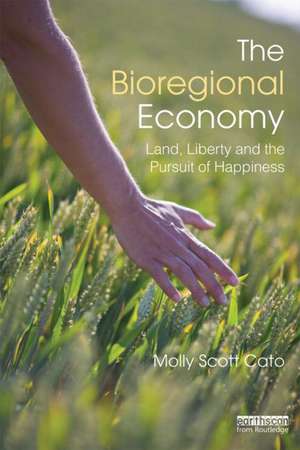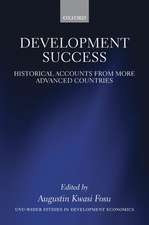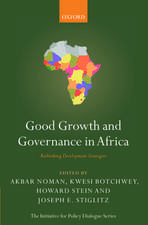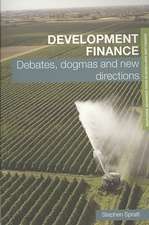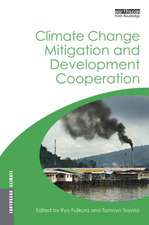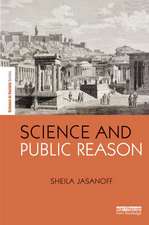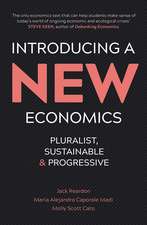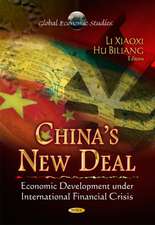The Bioregional Economy: Land, Liberty and the Pursuit of Happiness
Autor Molly Scott Catoen Limba Engleză Paperback – 16 noi 2012
A bioregional approach to economics assumes a different system of values to that which dominates neoclassical economics. The global economy is driven by growth, and the consumption ethic that matches this is one of expansion in range and quantity. Goods are defined as scarce, and access to them is a process based on competition. The bioregional approach challenges every aspect of that value system. It seeks a new ethic of consumption that prioritises locality, accountability and conviviality in the place of expansion and profit; it proposes a shift in the focus of the economy away from profits and towards provisioning; and it assumes a radical reorientation of work from employment towards livelihood.
This book by leading green economist Molly Scott Cato sets out a visionary and yet rigorous account of what a bioregional approach to the economy would mean — and how to get there from here.
| Toate formatele și edițiile | Preț | Express |
|---|---|---|
| Paperback (1) | 418.22 lei 6-8 săpt. | |
| Taylor & Francis – 16 noi 2012 | 418.22 lei 6-8 săpt. | |
| Hardback (1) | 1015.82 lei 6-8 săpt. | |
| Taylor & Francis – 16 noi 2012 | 1015.82 lei 6-8 săpt. |
Preț: 418.22 lei
Nou
Puncte Express: 627
Preț estimativ în valută:
80.03€ • 83.77$ • 66.61£
80.03€ • 83.77$ • 66.61£
Carte tipărită la comandă
Livrare economică 31 martie-14 aprilie
Preluare comenzi: 021 569.72.76
Specificații
ISBN-13: 9780415500821
ISBN-10: 0415500826
Pagini: 272
Ilustrații: 24 black & white illustrations, 11 black & white tables, 9 black & white halftones, 15 black & white line drawings
Dimensiuni: 156 x 234 x 18 mm
Greutate: 0.5 kg
Ediția:New.
Editura: Taylor & Francis
Colecția Routledge
Locul publicării:Oxford, United Kingdom
ISBN-10: 0415500826
Pagini: 272
Ilustrații: 24 black & white illustrations, 11 black & white tables, 9 black & white halftones, 15 black & white line drawings
Dimensiuni: 156 x 234 x 18 mm
Greutate: 0.5 kg
Ediția:New.
Editura: Taylor & Francis
Colecția Routledge
Locul publicării:Oxford, United Kingdom
Cuprins
Part I: Making Sense of the Bioregion 1. Why Bioregional Economics? 2. Visioning the Bioregional Economy 3. The Economist as Shaman Part II: Bioregional Resourcing 4. Firms, Farms and Factories 5. Provisioning and Provenance 6. Work as Craft 7. What About My iPad? Part III: Policies for a Bioregional Economy 8. Sharing our Common Wealth 9. Provisioning, Exchange and Sufficiency 10. Space, Limits and Boundaries 11. Living the Full Circle of Life
Notă biografică
Molly Scott Cato is Professor of Strategy and Sustainability at Roehampton University, UK. She is the author of Green Economics: An Introduction to Theory, Policy and Practice (Earthscan, 2008) and she has written widely on themes concerned with mutualism, social enterprise, policy responses to climate change, banking and finance, and local economies. She is a Director of Transition Stroud and of Stroud Common Wealth.
Recenzii
'Leading green economist Molly Scott Cato argues that science presents irrefutable evidence that the present economic system poses threats to the sustainability of the earth's ecosystems. Rather than impose limits and restrictions on resource use, she calls for the re-enchantment of our relationship with the biospher through imaginative creativity.'
'Although written with an academic market in mind, this work is far from being a dull, negative critique of the finance-dominated global economy. On the contrary, it is packed with insights into workable alternatives.'
- Frances Hutchinson, The Social Artist, Spring 2014.
'Although written with an academic market in mind, this work is far from being a dull, negative critique of the finance-dominated global economy. On the contrary, it is packed with insights into workable alternatives.'
- Frances Hutchinson, The Social Artist, Spring 2014.
Descriere
This book by leading green economist Molly Scott Cato sets out a visionary and yet rigorous account of what a bioregional approach to the economy would mean — and how to get there from here.
